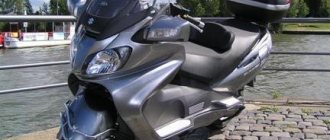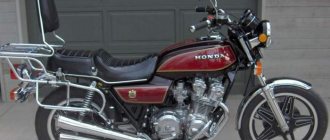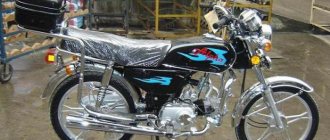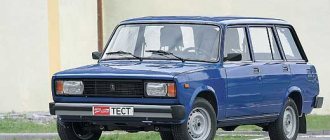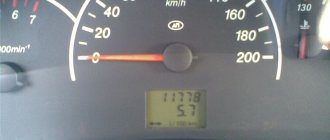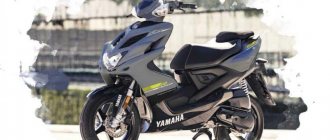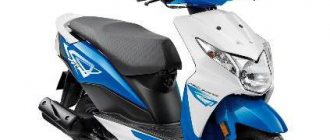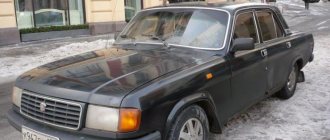"Orion" is a representative of the Russian brand Stels
Mopeds of the Orion family are becoming increasingly popular motor vehicles in our country. They are assembled at the enterprises of the Russian holding Velomotors under the Stels brand. “Orion” is a moped made on the basis of Chinese components, but some of its key elements were manufactured at Stels factories in Russia.
At the Zhukovsky Motorcycle Plant they make a frame and some external elements for these light motorcycles. The company strives to replace imported parts, and every year the share of Russian-made parts and mechanisms in the design of these mopeds increases.
Mopeds, photos of the assembly line of which are presented in the article, undergo the final stage of quality control.
Where were the Orion moped models developed?
The basic designs of the Orion family of models, as well as their engines, were developed by the Japanese company Honda. Mopeds made in China using these Japanese technologies have long been known on the Russian market and enjoy deserved popularity. The similarity of the Stels “Orion” models with the well-known Chinese analogues of the “Alpha” and “Delta” types is no coincidence, and there are no fundamental differences between them, however, the Russian company strives to expand the Chinese model range through its own development of new configurations, affecting both the chassis and design elements. "Orion" is a moped that should have the widest range of applications on Russian roads. The Japanese prototype contained such successful technical solutions that made it possible to create models of light, universal-purpose motorcycles based on them.
"Orion" - a moped with high technical characteristics
The technical characteristics of the Orion family of motor vehicles are similar to similar Chinese models, mainly due to the same engines and most chassis elements. The engine design was developed in Japan more than half a century ago, and the first Japanese scooters with this type of engine were called Honda Cub.
The engines on the Orions are clones of the Japanese prototype, manufactured in China, and can have various piston configuration options - from 50 to 120 cc. see. General technical characteristics for engines installed on all such models are the presence of one cylinder, four-stroke cycle, air cooling, circular gear shift, four-speed transmission, identical timing and gearbox design.
Depending on engine size, power can vary from 3.5 to 7.5 liters. With.
The maximum speed that the Orion 125 A is capable of can exceed 100 km/h due to the powerful 120 cc engine option. see. The design of the engines makes it easy to change their volume and power by replacing the piston group. "Orions" have approximately the same dimensions and weight from 81 to 87 kg.
UAV "Orion" and its weapons
Calendar page with an interesting photo
This year, the Russian armed forces received the first Orion unmanned aircraft complex for reconnaissance and strike purposes. By this time, the complex had passed all the necessary tests, incl. showed his combat potential. However, a drone with a suspended combat load was shown for the first time only now.
New photo
On the eve of the New Year, the Ministry of Defense traditionally publishes corporate calendars, which use photographs of modern and promising domestic equipment.
In May 2021, the owner of such a calendar is invited to admire the “Pacer” reconnaissance and attack UAV. At the same time, the photograph on the calendar page is of great interest. The photo shows the Orion UAV, created as part of the Pacer development work, in a cloud of smoke. The device has a previously undemonstrated desert camouflage coloring. KAB-20 small caliber aerial bombs are installed on the underwing and ventral pylons.
It should be recalled that at the Army 2020 exhibition, together with Orion, a variety of small-sized and mass-sized aircraft weapons, as well as pylons for their suspension, were already demonstrated. However, a UAV with a weapon under the wing was shown for the first time - even if in a processed form, with effects and as part of a calendar.
Drone with weapon
The “Pacer” R&D project was launched in 2011, and its goal was initially to create a UAV for reconnaissance and strike purposes. The design of the unmanned platform took several years, and in 2021, flight tests of the finished UAV with the main part of the electronic equipment began. Later, the first information about the possible composition of weapons appeared, and then at exhibitions they showed ready-made samples of on-board equipment and ASP.
"Orion" and its weapons at Army 2020. In the foreground is an X-50 missile, behind it are KAB-20 bombs. Source: bmpd.livejournal.com
As it became known later, testing the strike capabilities of the UAV began in 2021. During these tests, Orion used aerial bombs of an unnamed type. In the same year, the complex was sent to Syria for testing in a real airbase. However, there the drone worked only as a reconnaissance aircraft.
The other day, RIA Novosti, citing its sources in the industry, reported new tests. Launches of air-to-ground guided missiles were carried out for the first time at the test site. The targets were hit successfully. In addition, the use of gliding guided bombs was tested. It is noted that as a result of such events, Orion became the first domestic UAV capable of carrying and using missile weapons. However, the specific types of ASP involved in the tests were again not named.
UAV as a platform
"Orion" belongs to the class of medium-altitude long-duration drones (the English term MALE is widely used - Medium Altitude Long Endurance).
This device has fairly high flight performance characteristics and a solid carrying capacity, which makes it a good platform for deploying missiles and bombs. With a wingspan of more than 16 m and a length of 8 m, Orion has a take-off weight of 1 ton. Payload is up to 200-250 kg. Cruising speed is stated at 120 km/h, the maximum is unknown. The device is capable of operating at altitudes up to 7.5 km. Depending on the load and configuration, the UAV can remain in the air for about a day.
The drone is equipped with a set of radio-electronic systems for various purposes. The most noticeable component is the optical-electronic station in the characteristic fairing under the bottom. With its help, the UAV can conduct reconnaissance, as well as search for targets for the use of weapons and monitor the results of the strike. A radar station and electronic reconnaissance system are also offered for use.
Removable weapons pylon
To use UAVs as a weapon carrier, removable pylons are used. One such device is mounted under the wing and another is placed under the fuselage. Apparently, several types of suspension system have been developed. One of the pylons was shown at Army 2020, and the Ministry of Defense calendar shows a different system.
Ammunition nomenclature
It became known quite a long time ago that the Orion UAV will be able to carry and use guided missiles and bombs of several types.
Small-caliber ammunition was developed especially for it, corresponding to the limited carrying capacity of the device. Models of such products were publicly demonstrated several months ago. For Orion - and in the future for other medium or heavy attack UAVs - a whole range of guided bombs is intended. They are made in calibers 20 and 50 kg. A gliding aerial bomb UPAB-50 with a warhead from a Grad missile system is proposed. A similar charge is carried by the KAB-50 product, which can be equipped with an infrared, television and laser homing head. There is a simplified FAB-50 bomb.
The smallest in the range are the KAB-20 bombs. With a mass of approx. 21 kg such a product carries 7 kg of explosive. Modifications with satellite and laser guidance have been created.
The X-50 guided missile has been developed. This product is 1.8 m long with a body diameter of 180 mm. The mass of the rocket is 50 kg, of which up to 20 kg is the warhead of the required type. The missile can be equipped with different types of seekers. Flight performance characteristics were not reported.
Scout and attack aircraft
The Orion is reported to be the first medium-sized reconnaissance and strike drone to be delivered to Russian army units. Along with it, a whole range of new ammunition should enter service - and in the future it is possible to create new products with certain features and different characteristics.
Aircraft bombs of 50 kg caliber. Source: bmpd.livejournal.com
Using standard optical means, the Orion UAV is capable of observing the terrain and searching for targets. Then, using existing types of TSA, the drone will be able to strike ground targets within a radius of at least several kilometers. Weapons with warheads weighing from 7 to 20 kg are capable of effectively hitting manpower, lightly armored vehicles and unfortified structures. Inferior in power to “full-size” bombs and missiles, new products are capable of filling the empty niche of less heavy anti-aircraft missiles and expanding the flexibility of using combat aircraft, manned and unmanned.
The high combat potential of unmanned systems with such capabilities has been repeatedly demonstrated during real conflicts in recent decades. Reconnaissance and attack UAVs have proven themselves to be a useful and convenient addition to manned tactical aircraft, capable of taking on individual tasks and reducing risks to people.
Unfortunately, until recently, only foreign countries, but not Russia, had complexes of this class. This year, work on the Orion and its weapons was completed, and the first complex was transferred to the armed forces. Development of several other medium and heavy reconnaissance and strike UAVs also continues. Thus, over the next few years, the Russian Aerospace Forces will have a full-fledged fleet of new drones with wide combat capabilities.
The situation in the field of domestic unmanned aircraft is developing and constantly changing for the better. Among other things, this should be reflected in the information background. Thus, just one photograph of the Orion UAV with bombs under the wing and fuselage is now becoming almost a sensation. But we can expect that in just a couple of years, such drones will become a common element of the Air Force, and pictures of them in any configuration and with different weapons will no longer attract so much attention.
Moped "Orion" with a rack on the gas tank
There are two main variations in the Orion family of models, differing in frame shape and gas tank configuration. Models with a universal frame, which have a metal luggage basket above the gas tank, belong to type “A” and are equipped with engines from 50 to 100 cc. cm.
This is a very popular moped - “Orion”, its price ranges from 17 to 23 thousand rubles. Thanks to its high cross-country ability and convenient layout of the trunk on the frame, this model is especially loved by Russian buyers from rural areas. The Orion 50 (72) A moped can have wheels with both alloy wheels and spokes. The engine installed on this model is very easy to modify by replacing the piston group with a more powerful version. This can be done with your own hands, since the design of the engine is very simple.
The Orion 100 A with an engine capacity of 99 cc has a slightly longer base and seat shape. cm. Depending on the design of the wheel - with discs or spokes - the price for this moped ranges from 20 to 21.7 thousand rubles. These models have a relatively small gas tank of 3 liters.
Interesting facts about the constellation Orion
The oldest recovered star map is a map of the constellation Orion. In 1979, during excavations in a cave located in the Ach Valley (Germany), archaeologists discovered a 32,500-year-old ivory tablet. The carving on this tablet resembles the image of Orion, the hunter.
The existence of exoplanets in the constellation is very likely
Researchers have long hypothesized the existence of exoplanets, or extraterrestrial planets, near stars associated with this constellation. CVSO 30, a star located about 1,200 light-years from Earth, is thought to contain two massive gas giants; CVSO 30 b and CVSO 30 c.
The CVSO 30 planetary system (if it really exists) is itself unique. The relative distance of both planets from their parent star is something that has never been observed before. While CVSO 30 b orbits the star in less than 11 hours, CVSO 30 c takes more than 27,000 years to do the same.
This can be used to navigate to other (prominent) stars.
Orion as a star guide | Image credit: Mysid/Wikimedia commons
If you extend Orion's belt to the west (northwest), the first bright star you encounter is Aldebaran. The star is part of the constellation Taurus and is located approximately 65 light years from our solar system.
In the exact opposite (southeast) direction of the belt lies Sirius. It is the brightest star in the night sky and part of the constellation Canis Major.
Procyon, the brightest star in the constellation Canis Minor, can be found by following an imaginary line from Bellatrix through Betelgeuse, extending east. Likewise, a line from Rigel through Betelgeuse leads us to Pollux, a giant star in the constellation Gemini.
The future of this constellation
Simulation of Orion's regular motion since 50,000 BC. to 50,000 AD
Stars never remain stationary as they continually move throughout the galaxy. However, these movements are too slow to be observed during a human lifetime. Ultimately, the stars in the Orion constellation will move and rearrange themselves over tens of thousands of years.
Using data from the Gaia and Hipparcos missions, the European Space Agency produced simulations that show us what the constellation will look like in the next 450,000 years.
Betelgeuse, the red supergiant that represents the left shoulder of the Hunter constellation, is expected to explode (go supernova) sometime in the next 100,000 years or so. Many new stars will also be born from the molecular cloud surrounding this region.
Models with a large gas tank and case
Models with six- and eight-liter gas tanks and a trunk case are equipped with engines ranging from 50 to 120 cc. see and belong to type “B”. The Orion moped, a photo of which can be seen below, has a layout that differs from type “A”.
A very important difference between types “A” and “B” is the different position of the hands when landing. Type A models have a higher steering wheel and are easier to control. Model “B” provides a position for the motorcyclist that helps reduce drag.
The Orion 125 V moped differs from the Orion 50 V (72) only in its greater weight and 120 cc motor power. The noticeable difference in the power of the Orion engines creates very large differences in their dynamic characteristics. "Orion" 110 is a moped, which, according to the traffic rules of the Russian Federation, should be considered a motorcycle. It is the same "B" variety with a large gas tank and rear case, with a corresponding 110 cc engine. cm. The price for model “B” ranges from 21 to 27 thousand rubles.
There are luxury options in the Orion family. "Orion" Lux is equipped with an alarm system and a more powerful 120 cc engine. see. Structurally, this option belongs to type “B”. Price – from 31 thousand rubles. The second luxury option, the Orion City moped, has approximately the same price. This model has beautiful sporty plastic contours, a muffler with a sloping rear part, a powerful engine and an alarm system. This model also belongs to type "B". The cheapest option from subgroup “B” is the Orion 50 moped.
Specifications
The weight of the motorcycle is 73 kg, its length and wheelbase are 1900/1230 mm, respectively. Mini trips become more comfortable with a moped’s ground clearance of 80 mm, that is, shallow holes, elevations and bumps are not dangerous for the “stallion”. Fuel consumption is quite economical at 3.5 liters per 100 km, while on a moped you can accelerate to 85 km/h. This model is double, with a maximum load capacity of 138 kg.
A 4-stroke engine with one cylinder is installed. The working volume according to the documents is 97.2 cm3. You can start the engine by pressing the electric starter and operating the kickstarter. The engine is cooled by a counter flow of air, the main unit is fed with fuel through the carburetor system. The control, although mechanical, is quite acceptable: the transmission is 4-speed, a chain is installed (under the casing). The spinal type frame is made of steel. The front and rear tire sizes are 2.50–17 and 2.75–17, respectively.
Differences from Chinese counterparts
Both types of Orions (types “A” and “B”) are very similar to their Chinese counterparts - mopeds of the “Delta” and “Alpha” types. The chassis, engines, both sprockets, chain, brake drums and many other important structural elements are the same. But still, the Russian assembly of the Stels brand has a number of important differences. And one of them is higher quality fasteners. Mopeds assembled in China require mandatory tightening of all elements without exception before use.
The fasteners used in Orions are more durable in material and are also stretched to a higher quality at the factory. Models of both types “A” and “B” have practically no design differences as standard from their Chinese counterparts. But the Orion 100A has a more comfortable seat, a slightly longer base and stronger wings. During driving, the front fenders on models 50 (72) A and B, made of thin stamped iron, are very often destroyed by vibration. Orions have a more durable and comfortable frame and rear wheel pendulum, which has a positive effect on the reliability of fixing the rear wheel tensioners, as well as on the convenience of replacing the air filter. One of the positive consequences of using higher-quality metal in the manufacture of the frame in Orions is the absence of destruction of the engine mounting points, while in Chinese analogues these components are susceptible to destruction when operating the version with 110 - 120 cc engines. cm.
Functional differences in the Orion moped family
"Orion" is a universal-purpose moped. Thanks to various engine options, which differ quite significantly in terms of energy output, these motorcycles can have speed characteristics comparable to light motorcycles. Thanks to their low weight and large wheels, these lightweight motorcycles move well over rough terrain and on dirt roads. In urban conditions, when it is necessary to maneuver among traffic jams, Orions are comparable in handling to ordinary bicycles. But differences in the power of power plants impose certain limitations. Models with 50 cc engines cm (49 cc according to documents) are more convenient for use in rural areas when driving on a dirt road at low speed. They are too slow for the city and highway, although they have some advantages in fuel economy and in the absence of the need to have a license with a category that allows driving motorcycles. According to traffic rules, “Orions” with such engines are real mopeds. All other versions of the Orions should be considered light motorcycles, which require the appropriate license to operate. The most powerful Orions, capable of accelerating to hundreds of km/h, are the most versatile options, which are suitable for driving around the city and highway, as well as on dirt roads and rough terrain.
Mysteries of the constellation Orion
The constellation Orion is very mysterious; the fact is that the constellation exactly follows the contours of the Kola Peninsula and the coast of the White Sea. And on the terrain of the Kola Peninsula, the constellation is marked by labyrinths and sanctuaries made by man.
There is such a legend about the Hyperboreans. Hyperborea, according to ancient Greek mythology, inherited all the traditions of ancient civilizations and is located somewhere in the north.
Murmansk region and the constellation Orion
According to ancient Greek myths, the Hyperboreans are the heirs of the ancient titans, and Apollo himself visited this mysterious civilization more than once in a chariot.
In 2005, a group of international scientists, taking into account all the scientific expeditions made to the North of Russia, made many interesting discoveries. If you are interested, then read about it. All this is quite interesting and then decide whether to believe it or not. Although this all sounds quite plausible.
You see how interesting and amazing the constellation Orion is, find it in the starry sky. We would also like to recommend that you pay attention to the constellation Canis Major, where you will also find many mysteries.
The most optimal model of the Orion moped
If low-speed models with engines up to 50 cc. cm are suitable only for leisurely trips outside the city, then for models with engines from 110 cc. see there are also several significant shortcomings. Firstly, they consume more fuel. Secondly, the lightweight frame design and rather weak chassis elements, especially the chain and sprockets, when the moped is equipped with 110 cc engines. see and above have a much greater degree of wear and are not designed for such loads that arise with a motor power of 6-7 hp. With. Also, such engines sharply increase vibration loads, which leads to rapid wear of many important components and parts not directly related to the chassis.
The timing belt of more powerful engines installed on Orions requires more frequent checking and replacement of rollers and chains. Thirdly, engines from 110 hp. With. require a motorcycle license and serious driving skills. The optimal version of the Orion moped model, which will be convenient and safe for most lovers of this type of transport, is the medium version with a motor power of 5.7 liters. With.
Bright stars of the constellation Orion
The stars of Orion are impressive. This constellation is especially rich in giants and supergiants. New stars are constantly being formed here, thanks to the many bright hydrogen nebulae.
Rigel
Let's start our short review with the beta constellation of Orion - a star called Rigel. Although this star comes second and is designated by the letter β, it is the brightest star of this constellation. Its magnitude is 0.3m and it is classified as a blue supergiant. Rigel emits light 130,000 times more than our Sun, and its surface temperature reaches more than 12,000 K. Rigel is 74 times larger in diameter than the Sun, and 17 times heavier.
Rigel is considered one of the most powerful stars in our Galaxy. If this star suddenly appeared in the place of the Sun, then the Earth would suffer a sad fate - it would be instantly evaporated, and the remains would be immediately carried away by the stellar wind.
Among other things, Rigel is a variable star with an unstable cycle of 22-25 days, although this is a typical phenomenon for supergiants. The gloss varies from 0.03 to 0.3m.
Moreover, Rigel is also a multiple star, or rather a triple star. The main component is a blue supergiant called Rigel A, and the second component, Rigel B, is a close system of a pair of hot blue stars with a mass of 2-3 solar. A couple of components can be distinguished even in a rather modest 70-mm telescope, but the components of Rigel B cannot be seen individually - the system there is too crowded, orbiting in just 10 days.
Rigel system. Component B is also a binary system.
The distance to the crossbar is estimated from 700 to 900 light years, according to different methods. However, despite such a huge distance, this star is still one of the brightest in our sky. Can you imagine its power there, up close?
Betelgeuse
Rigel is impressive in its size, but it is far from Betelgeuse - α Orion. This red supergiant also has a distinct red tint in the sky. Betelgeuse is about 1000 times larger than the Sun, and it emits 105 thousand times more light.
Like many supergiants, Betelgeuse is a semi-regular variable star. It pulsates, sometimes increasing its volume, sometimes decreasing. If this star were placed instead of the Sun, its surface would fluctuate from the orbit of Mars to the orbit of Jupiter, and the Earth would be inside. As the star expands, its density and temperature decrease, and as it contracts, it increases (and becomes brighter).
See what this supergiant would look like in the sky from different distances - 8, 28 and 64 astronomical units. For comparison, we see the Sun from a distance of 1 AU. The images were obtained using the Space Engine program - the best simulator of the Universe today (and free).
The distance to Betelgeuse is estimated to be from 500 to 640 light years, that is, somewhat closer than Rigel.Betelgeuse is of great interest to scientists. On June 19, 2017, a photograph of the surface of this star was taken using the ALMA telescope. This was the first ever photograph of the surface of a star other than the Sun.
Photo of Betelgeuse taken by the ALMA telescope.
The fate of this huge star is also curious. In the near future, Betelgeuse will explode, creating a bright supernova that will shine in our sky for several months with almost the brightness of the Moon. Around this event, various predictions are already being made about the death of all life on Earth and the like. However, in reality, the explosion of Betelgeuse will, of course, not happen tomorrow or the day after tomorrow - years, decades, centuries may pass... And there is no danger for the Earth - too much distance separates us.
Bellatrix
Bellatrix is the third brightest star in the constellation, γ Orionis. It is not as bright as Rigel or Betelgeuse, but it is also quite noticeable. If you look at the constellation when the air is clear enough, you can easily notice how Betelgeuse glows red, while Rigel and Bellatrix are noticeably blue. It looks beautiful.
Bellatrix is a blue-white giant with a magnitude of 1.26m and is one of the brightest stars in our sky. This star is even much hotter than Rigel - its surface temperature reaches 21,000 K. Although it is only 5.7 times larger in size than the Sun, it emits 4000 times more light.
Bellatrix, like many giants, is a variable star. It changes gloss within 6%. Due to the high rotation speed, matter flows from its equator at a speed of 1600 km/s. Therefore, Bellatrix is classified as an eruptive variable.
This is a young star, its age is only about 10 million years. However, her life will be short, albeit bright. In about a million years, its resources will run out and it will turn into a red giant.
Bellatrix is located 243 light years away from us, that is, closer than the other main stars of the Orion constellation.
Other notable stars in the Orion constellation
The constellation is rich in bright and hot stars. For example, three stars in Orion's belt are very hot. ζ (Alnitak) and δ (Mintaka) are rare spectral class O, and ε (Alnilam) is a hot giant, emitting 375,000 times the light of the Sun, and all have a surface temperature of more than 25,000 K. Alnilam will soon become a red supergiant , which will be brighter than Betelgeuse, and then explode as a supernova, and now the star is losing matter and is surrounded by a molecular gas nebula.
Stars of Orion's Belt. From left to right - Alnitak, Alnilam and Mintaka.
Mintaka is an eclipsing variable star that consists of two hot components orbiting with a period of 5.63 days. Their luminosity is 90,000 times greater than that of the sun, and both stars face the fate of supernovae. The distance to this system is about 900 light years.
σ and λ Orionis also belong to the rare spectral class O, with λ being the hottest star in the entire constellation, with a surface temperature of 30,000 K.
Reviews from owners of Orion mopeds
Reliable and unpretentious equipment produced under the Stels trademark has every reason to be loved and recognized by customers. Orions are more reliable than their Chinese counterparts. If you study the reviews of the owners of this type of equipment, the overwhelming majority speak for the clear advantages of the Orions over the Chinese Alphas and Deltas. Positive reviews primarily concern a stronger and more reliable frame. This element is manufactured in Russia at Stels factories. When comparing Stels and their Chinese counterparts, they also note on the positive side the rear shock absorbers and fewer breakdowns due to weak fasteners. Many note the consistency of the quality and price of Orion mopeds, the availability of spare parts, maintainability and the ability to operate in adverse off-road conditions. Experienced moped owners note the importance of following all break-in rules, the need to monitor the condition of the fasteners and correctly adjust the operation of the clutch, fuel supply, and drive chain tension. The mopeds, photos of which are presented below, have traveled more than 20 thousand km.
Breakdowns that owners of Orion mopeds complain about in reviews
The most common faults are:
- Carburetor adjustment failure.
- Sprocket wear and drive chain stretch.
- Failure of the turn signal switching relay.
Serious malfunctions that may occur due to improper operation and lack of control over the operation of the moped mechanisms:
- Loss of compression due to improper valve adjustment, valve burnout.
- Timing chain rupture due to wear of its tension system.
- Clutch failure due to improper adjustment and cable stretching.
- Failure of chain tensioners, as well as deformation of tensioner fixing points due to wear of the sprockets and the chain itself.
